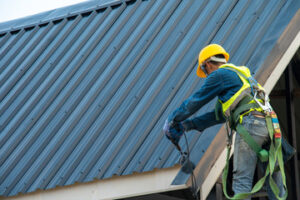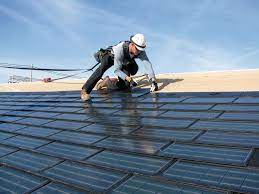Choosing the right contractor is essential for any home improvement project. You want to find a company you can trust to do the work and will be there for future problems.

A great name reflects who you are and what you do best. It tells folks, “These guys know roofs.” Contact Roofing Company Murfreesboro for professional help.
Choosing a licensed roofing contractor is one of the best ways to ensure that your roof project will go smoothly and safely. Not only does being licensed and insured show that a company has the necessary skills, but it also means that they will adhere to all local building codes and requirements. Additionally, reputable roofing contractors will offer warranties on both their materials and their workmanship. This way, if you ever have any problems with your roof in the future, you can contact the roofing contractor and have it fixed.
Licensed contractors are more likely to use premium roofing materials and follow proper installation techniques. This results in a roof that lasts longer, requires fewer repairs, and maintains its warranty protection for a longer period of time. By contrast, unlicensed contractors may skimp on quality materials and shortcut installation procedures, which can result in a subpar roof that fails prematurely.
Another reason to choose a licensed roofing contractor is that they are more likely to carry general liability and workers’ compensation insurance. This protects you from any financial responsibility if the roofing contractor causes damage to your property during the project. For example, if a worker falls off of your roof and breaks their leg, workers’ comp will cover the medical expenses.
In addition, a licensed roofing contractor is more likely to have established relationships with reputable suppliers and can source high-quality roofing materials. Moreover, they will have the resources and manpower to complete your roofing project within an agreed upon timeline. Choosing an unlicensed contractor, on the other hand, could result in lengthy delays and additional costs for you.
In order to verify the licensing status of a roofing contractor, you can visit your state’s business license website and search by name or license number. Then, you can compare the information with other business records to ensure that the roofing company is valid and up-to-date. This is a fast and easy way to ensure that you are working with a licensed and reputable roofing contractor. In the end, it will save you both time and money, and it will help you avoid costly mistakes during your roofing project.
Local Online Reviews
Having a solid local online presence is a key factor for roofing contractors looking to attract nearby customers. This means optimizing their website content for relevant keywords and leveraging reputable local directories, while also encouraging happy customers to leave reviews and citations. Ultimately, these efforts help ensure that roofing businesses appear prominently in local search results for queries like “roof repair near me” or “best roofers in my area,” resulting in more qualified leads and increased visibility.
Online reviews provide a valuable snapshot of past experiences with particular roofing companies, offering insight into the level of service and quality to expect. Look for reviews that address a variety of topics, including customer service, project timelines, and pricing. If you notice that a company has more positive than negative reviews, this may be a good sign, as it indicates that the vast majority of their customers are pleased with their work.
Additionally, trustworthy roofing contractors will be transparent with their pricing practices. If a contractor gives you an estimate that’s significantly higher or lower than other quotes you’ve received, this could be a red flag. Also, a reputable roofer will be willing to share photos of previous roofing projects they’ve completed. If a contractor doesn’t have a photo gallery on their website, this is another reason to steer clear.
Effective local SEO is a critical strategy for roofing businesses seeking to maximize their visibility in specific geographic areas. This includes claiming and optimizing Google Business Profiles, accumulating positive reviews, and ensuring NAP consistency across their online platforms. Moreover, creating local content such as blog posts about common roofing problems in specific regions or guides on seasonal roof maintenance in local communities can further enhance a roofing business’s local visibility.
When choosing a roofing company, it’s important to take the time to research and select one that can meet your needs. Taking the time to research and verify a company’s credentials, review customer feedback, and check their licensing and insurance are all steps that can help you choose the right roofing contractor for your home or business.
Warranty
A warranty is a crucial safeguard for homeowners, offering protection from unforeseen costs associated with roof repairs and replacement. However, not all warranties are created equal, and it’s important to understand what your specific warranty covers before making a purchase.
Most roofing companies offer a warranty on their work, but it’s also important to find out about the manufacturer’s warranty for the materials used in the roof. Typically, roofing companies will back the manufacturer’s warranty with their own workmanship guarantee. It’s also important to read and understand the manufacturer’s terms of warranty and any conditions or restrictions that may apply.
Workmanship warranties typically cover a certain amount of repair and replacement for the duration of the warranty, but they do not always cover everything that can go wrong with a roof. For example, a warranty will typically not cover issues caused by severe weather or neglecting routine maintenance.
The best roofing companies will offer a comprehensive warranty that includes both material and labor coverage. This type of warranty is often considered the most beneficial option for homeowners. However, comprehensive warranties can sometimes be more expensive than other options.
It’s also important to note that most roofing warranties include some standard exclusions. These can include anything from natural disasters to acts of God, as well as damage caused by third parties or by homeowner-caused modifications or changes. It’s important to review the warranty’s terms and conditions carefully to understand what is and isn’t covered, and to work with a roofing company that will provide you with complete peace of mind.
It’s also important to understand that your warranty may become void if you do not follow the manufacturer’s instructions regarding installation and maintenance of your roof. For instance, most manufacturers require that you document any issues and contact them promptly to schedule a repair. Additionally, most manufacturers and roofing contractors will not uphold a warranty if the building owner fails to maintain routine maintenance and notify them of any problems promptly. Finally, it’s important to store your warranty documents in a safe place so that you can refer to them if needed.
